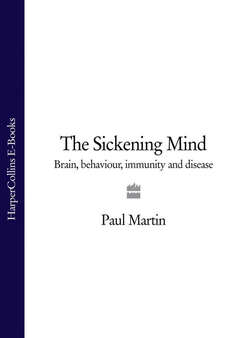Читать книгу The Sickening Mind: Brain, Behaviour, Immunity and Disease - Paul Martin - Страница 12
2 Shadows on the Sun
ОглавлениеHad she been light, like you,
Of such a merry, nimble, stirring spirit,
She might ha’ been a grandam ere she died;
And so may you; for a light heart lives long.
William Shakespeare, Love’s Labour’s Lost (1595)
In Tobias Smollett’s epistolary novel The Expedition of Humphry Clinker (1771), Mr Matthew Bramble makes this perceptive observation in a letter to Dr Lewis:
I find my spirits and my health affect each other reciprocally – that is to say, every thing that discomposes my mind produces a correspondent disorder in my body; and my bodily complaints are remarkably mitigated by those considerations that dissipate the clouds of mental chagrin.
Is the centuries-old notion that the mind plays a pivotal role in physical disease an established fact or unsubstantiated folklore? In this chapter we shall consider some of the many strands of scientific evidence for and against that notion. Precisely how the mind affects physical health is a question we shall leave until later. But first we must clear a conceptual hurdle out of the way.
The perfectly sensible idea that the mind can influence our susceptibility to disease is often muddled with the different, but equally venerable, notion that the mind can by itself conjure up phantom illnesses which have no physical basis. We are about to encounter the psychosomatic fallacy.
According to one fairly representative modern definition psychosomatic illness is ‘any illness in which physical symptoms, produced by the action of the unconscious mind, are defined by the individual as evidence of organic disease and for which medical help is sought’ [my italics]. By this definition, the unfortunate victim might feel ill even though he or she has no underlying physical disease. In other words, mental state is the sole and sufficient cause of the physical symptoms. Such things do, of course, happen; we shall take a look at them in chapter 3. But they are not a major concern of this book. In fact, they are something of a distraction.
Psychological and emotional factors can determine whether or not someone becomes ill but they mostly do this by altering that person’s susceptibility to disease. They are rarely the sole and sufficient cause of illness. A less misleading definition of ‘psychosomatic’ is one in which psychological factors play a contributing role in the development of the illness, alongside other factors such as bacteria, high blood pressure or smoking. But by this definition most illnesses in the Western world today can be termed psychosomatic.
The misleading conception of illnesses as mere phantoms, conjured up by the unconscious mind, has its roots in the psychoanalytic theories of Sigmund Freud. According to Freud and his disciples many mental and physical disorders have their roots in emotional conflicts, of which the patient may have no conscious awareness. These unconscious emotional conflicts are translated into physical symptoms such as pain, paralysis or loss of sensation. The symptoms are regarded by the sufferer – though not necessarily the rest of the world – as legitimate signs of a genuine organic illness. This dubious concept of psychosomatic illness lives on and can still be found lurking within the pages of popular health and self-help books.
Freudian psychoanalytic theories laid the foundations for what later became known as psychosomatic medicine, a field which came into being during the 1930s and 1940s. The earliest practitioners of psychosomatic medicine sought explanations for mysterious disorders such as asthma, allergies, arthritis, high blood pressure and peptic ulcers in underlying emotional conflicts and personality characteristics. Psychosomatic theories about asthma, for example, revolved around such notions as the fear of losing parental love. As a natural consequence of their Freudian leanings, many of the early psychosomatic practitioners tried to treat disorders like asthma and allergies using psychotherapy – with fairly mixed results.
We, on the other hand, shall be moving firmly within the realm of ‘real’ diseases like the common cold, herpes, coronary heart disease and cancer, rather than those shadowy and mysterious maladies to which the epithet psychosomatic is usually applied. The diseases we shall be focusing on in subsequent chapters are caused by real bacteria, real viruses, real clogged arteries or real cancer cells. They are most certainly not just ‘all in the mind’.
